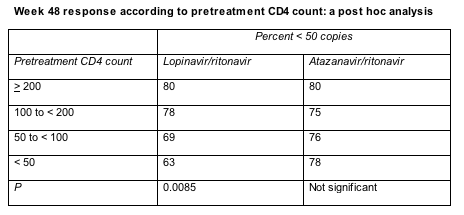 |
 |
 |
| |
Boosted Atazanavir Noninferior to Lopinavir in Previously Untreated People
|
| |
| |
15th Conference on Retroviruses and Opportunistic Infections
February 3-6, 2008
Boston
Mark Mascolini
Editor Jules Levin
Standard doses of atazanavir/ritonavir were reported to be non-inferior to the old capsule formulation of lopinavir/ritonavir after 48 weeks in the international CASTLE study of treatment-naive people [1]. But atazanavir takers had much better lipid profiles and suffered fewer gastrointestinal problems than people taking lopinavir.
The primary endpoint of the study was the proportion of patients with HIV RNA <50 copies/ml at week 48. The principle analysis was: ITT-Confirmed Virological Response (CVR) - (NC=F). The primary objective was to demonstrate noninferiority of ATV/r Reyataz/r) once daily vs LPV/r (Kaletra) based on the primary endpoint (delta -10%, ATV/r - LV/r).
Researchers on five continents randomized 440 people to start abacavir and 443 to start lopinavir, both with fixed-dose tenofovir/emtricitabine. Median pretreatment viral loads stood around 100,000 copies in both groups and median CD4 counts in the low 200s. While 58 people (13%) taking lopinavir dropped out of CASTLE by week 48, 39 (9%) quit atazanavir. Side effects accounted for only 3% of lopinavir dropouts and 2% of atazanavir dropouts.
At week 48 a noncompleter-equals-failure analysis (the primary endpoint) figured a 78% sub-50-copy rate with atazanavir versus 76% with lopinavir, a result establishing the noninferiority of boosted atazanavir to lopinavir. According to a week 48 time-to-loss-of-virologic-response analysis, 78% randomized to atazanavir and 76% randomized to lopinavir had fewer than 50 copies. In an on-treatment analysis, 84% taking atazanavir and 87% taking lopinavir ended 48 weeks with a load below 50 copies.
Among people beginning treatment with 100,000 or more HIV RNA copies, 74% taking atazanavir and 72% taking lopinavir had a 48-week viral load under 50 copies. Respective results for people starting with fewer than 100,000 copies were 82% and 81%.
In a post-hoc analysis (not planned before the CASTLE Study started although they did plan to look at responses by CD4 count), people who started lopinavir with lower CD4 counts had a lower virologic response rate than those starting with more CD4s (table; I removed the table). Patients were categorized at baseline in 1 of 4 CD4 group: >200, 100 to 200, 50 to 100, and <50. The percent <50 copies/ml declined with each lower level of baseline CD4s for patients on lopinavir/r. But for patients taking atazanavir/ the virologic response was similar regardless of baseline CD4 count. For example, patients who started the study with <50 CD4s and received lopinavir/r had a 63% response in achieving <50 copies/ml and patients receiving atazanavir/r had a 78% rate for achieving <50 c/ml. The number of patients in each CD4 category was relatively lower compared to the number of patients in the entire study. In the <50 CD4 count group 48 patients were on LPV/r and 58 were on atazanavir/r. Average CD4 gains through 48 weeks did not differ between atazanavir (203 cells) and lopinavir (219 cells).
For patients with 200 or more CD4s at baseline 80% in both the Kaletra (LPV/r) (n=222) and Reyataz/r (n=228) arms had <50 c/ml. The numbers of patients in the lower CD4 groups are lower. For patients with 100 to 200 CD4s at baseline 78% in the LPV/r arm (n=134) & 75% on ATV/r (n=106) had <50 c/ml at week 48. In the 50 to 100 CD4 group 69% in the LPV/r arm (n=29) & 76% in the ATV/r (n=45) arm had <50 c/ml at week 48. Only the differences in viral responses among the different CD4 groups among patients on Kaletra were reported as being statistically significant. In other words, for patients on Kaletra the reduced differences in viral load response between the different baseline CD4 groups was statistically significant. The authors did not report that a comparison between Kaletra & Reyataz based on viral responses within the respective different CD4 groups was significant.

Fifty-one people (12%) starting atazanavir and 42 (10%) starting lopinavir had a serious adverse event during the study. Proportions with a grade 2 to 4 adverse event were 26% with atazanavir and 30% with lopinavir. As one could predict, jaundice affected more people taking atazanavir and nausea or diarrhea troubled more people taking lopinavir.
While 2% randomized to atazanavir started antilipid therapy during the trial, 7% randomized to lopinavir turned to antilipid drugs. Even so, week 48 fasting lipid changes were uniformly worse with lopinavir:
- Total cholesterol: atazanavir +12%, lopinavir +24%
- Low-density lipoprotein cholesterol: atazanavir +12%, lopinavir +15%
- Non-high-density lipoprotein cholesterol: atazanavir +7%, lopinavir +21%
- Triglycerides: atazanavir +13%, lopinavir +51%
Liver enzyme elevations affected 2% or fewer in the two study arms.
The trial will continue through 96 weeks, and study participants may switch to the new lopinavir/ritonavir tablet after week 48. But Jean-Michel Molina (St. Louis Hospital, Paris) said most enrollees appeared to be sticking with the capsule.
Reference
1. Molina JM, Andrade-Villanueva J, Echevarria J, et al. Efficacy and safety of once-daily atazanavir/ritonavir compared to twice-daily lopinavir/ritonavir, each in combination with tenofovir and emtricitabine in ARV-naive HIV-1-infected subjects: the CASTLE study, 48-week results. 15th Conference on Retroviruses and Opportunistic Infections. February 3-6, 2008. Boston. Abstract 37.
|
| |
|
 |
 |
|
|